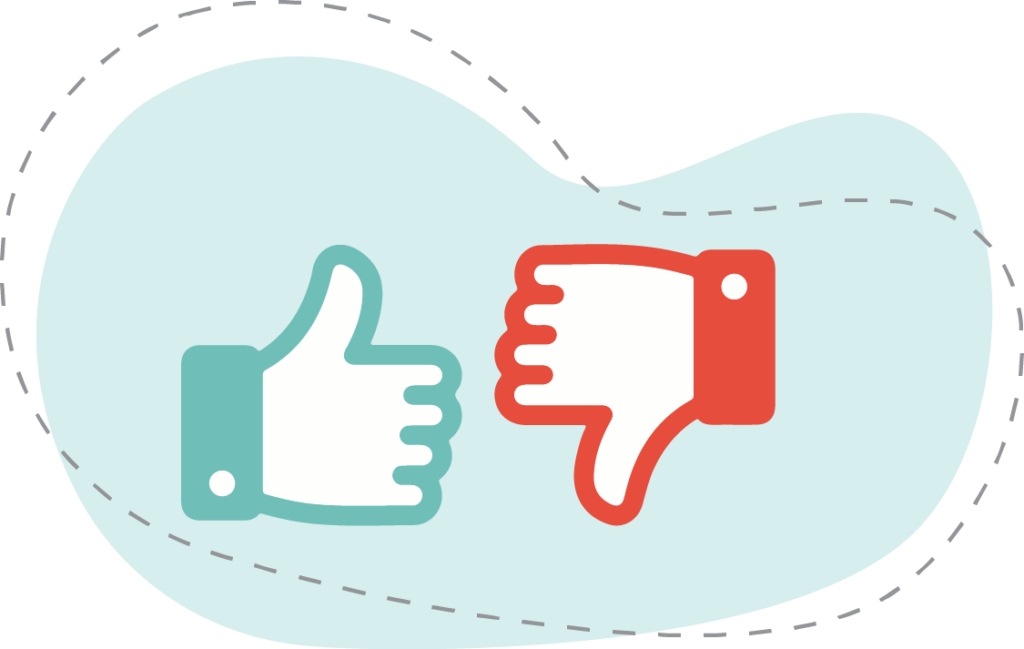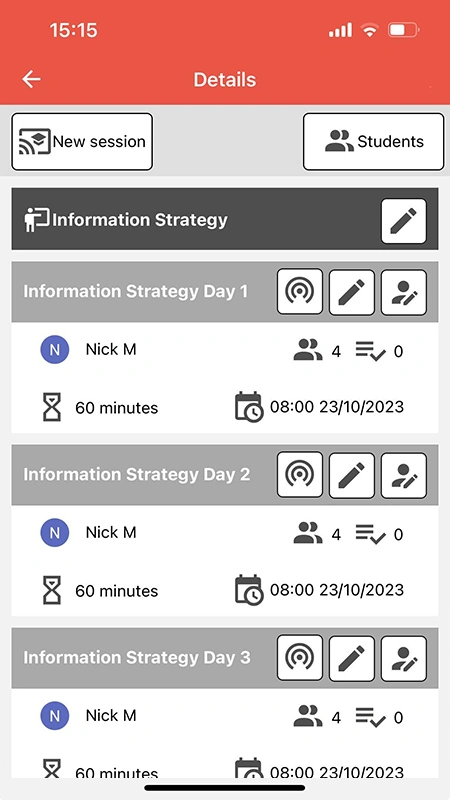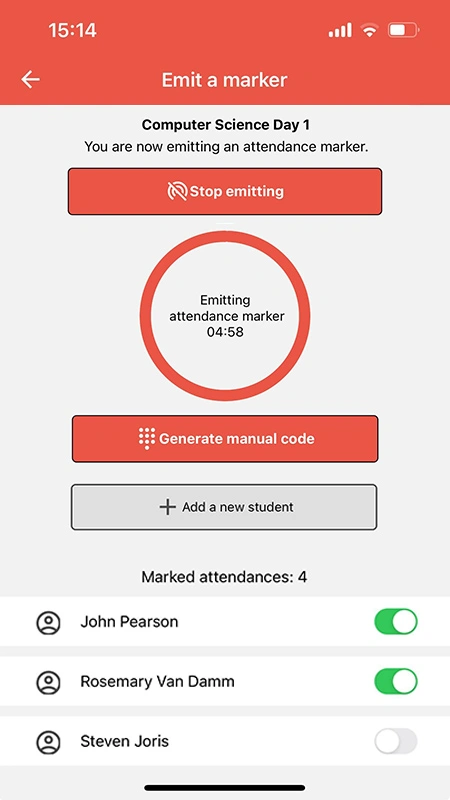
Student attendance tracking is a common and, in many cases, necessary procedure done by universities and schools. Attendance requirements in schools and universities require an efficient and reliable way to track attendance. This blog post focuses on the topic of student attendance tracking. We go over what it is, who does it, why and how is it done and our unique solution for this. Bear in mind that this blog post focuses on attendance tracking in on-campus classes, not covering attendance in online classes.
Key takeaways:
- Student attendance tracking is vital for fulfilling attendance requirements and ensuring safety in schools and universities.
- Various methods are used for tracking attendance, including roll-call, signing lists, QR codes, seat assignments, fingerprint scanners, badge cards, facial recognition, and mobile apps.
- Each method has its own advantages and disadvantages in terms of reliability, efficiency, and cost.
- Attendance tracking remains relevant in modern education as it supports quality education and student accountability.
- We offer a free mobile app, Attendance Radar, for student attendance tracking using a secure Bluetooth signal, providing a quick and reliable method for attendance management.
- Our expertise in privacy by design architecture makes our attendance tracking solution particularly valuable in sensitive environments.

What is student attendance tracking?
Student attendance tracking is the practice of taking notice of which students are attending classes, usually registering this in a system of the university/school to provide a record of which students have attended.
Who does attendance tracking?
Teachers in universities/schools are usually the ones that track students’ attendance. As well, university professors sometimes seek to take attendance in their lectures or ask an assistant to track the attendance.
Why do attendance tracking?
Universities carry out attendance tracking as students have minimum attendance requirements they need to fulfill to pass a particular course. Usually, students are allowed to miss some classes to leave room for emergencies that prevent students from attending, however they must meet a minimum percentage of classes attended and attendance tracking aids in confirming whether or not this requirement is met. Also, in some cases attendance is built into the grade of a course.
Schools track attendance also due to attendance requirements but also for safety reasons. Thus, if there is an emergency where the school needs to be evacuated, the attendance record can be consulted upon to make sure nobody is left behind and efforts to locate missing people can be quickly initiated.

How is student attendance tracking done? How are technologies used for attendance tracking?
- Roll-call attendance: This involves tracking attendance by calling out the students’ names to see if they are present.
- Signing a list/asking students to write down their names: This involves passing around a sheet of paper/an attendance list. Students can then mark themselves as present by either signing or writing down their name.
- QR codes scanned by students: This involves the teacher displaying a QR code which students scan to mark themselves present.
- Assigning seats to students: Consists on the teacher assigning a seat to every student at the beginning of the course. The teacher then checks whether a seat is empty or not to record the attendance.
- Fingerprint scanners: This involves students scanning their fingerprints in a fingerprint scanner as they enter the classroom. The scanner’s system then automatically registers the students’ attendance.
- Badge cards: This involves students scanning their student or badge card on a scanner to mark themselves present.
- Facial recognition: This involves the students showing their face to a facial recognition system to mark themselves present.
- Mobile apps: A mobile app can emit a signal which students receive in their own app and can mark themselves present by pressing. The signal has a limit in its range so that students that did not attend cannot mark themselves as present.

What are the advantages and disadvantages of the different student attendance tracking methods?
- Roll-call attendance: The main advantage of this is that it is easy to do and it can allow the teacher to directly register the students’ attendance into the system. It may be unreliable in the case the teacher misses a particular students’ response and fails to mark him as present. Additionally, it may be that if the teacher is not paying attention a student can say that his/her friend is present, when they are not, by responding to the teacher as they call out his/her friend’s name. Moreover, it can also be quite time consuming in larger classes.
- Signing a list/asking students to write down their names in a paper: Once again, this is quite easy to do and the teacher can quickly register the attendance into the system. Nevertheless, this method also suffers from reliability issues as students can sign for or write down the name of a friend of theirs that is not attending the class. Moreover, the teacher may also misplace the attendance list so they have no record of who actually attended.
- QR codes scanned by students: This is a faster method of taking attendance as the teacher only has to display the QR code and the students mark their attendance themselves. Nevertheless, big reliability issues can arise as students can take a picture of the QR code and send it to their friends that are not attending the class. QR codes that refresh after a period of time (e.g. every 30 seconds) reduce the reliability issues but can still be exploited by students if they are fast enough.
- Assigning seats to students: This student attendance tracking method is more reliable than the ones mentioned above as students cannot mark attendance for a friend given that they cannot be in two seats at the same time. Nevertheless, this method is still more time consuming as the teacher needs to check which seats are occupied and which are not, which might be hard if the classroom is big. Moreover, this method may also force students to sit somewhere they do not like through the entire duration of the course, which might make the experience unpleasant for them.
- Fingerprint scanners: The main advantage of this method is that it is more reliable as students are not able to cheat and register their friends as present in class given that they do not have access to their fingerprint. Moreover, it can be quite efficient if students can quickly scan their fingerprints at the end or the beginning of class leading to less wasted time. However, this method is quite costly as it requires hardware installation and the maintenance of a database with every students’ fingerprint. Also, hardware failures can create problems. There could also be ethical concerns about storing students’ biometrical information.
- Badge cards: Main advantage is that this method can be quite efficient as students can quickly scan their badges to mark themselves present. Nevertheless, it can be unreliable as one student can scan the badge of another student to mark them as present in class even if they did not attend. As well, the hardware installation and the fact that every students needs a badge card makes this method more costly. Moreover, hardware failures could also cause problems.
- Facial recognition: Main advantage is the efficiency of this method as it can quickly register students’ attendance similar to the two previous methods mentioned before. It can also be quite reliable as students’ are likely not able to register attendance for a friend. Nevertheless, poor facial recognition would allow students to show a photo of their friend’s face to give them attendance. Moreover, the required database with the faces of all students can create privacy issues. Privacy issues would be more relevant with underaged students. As well, the required hardware installation and development and maintenance student’s faces database can make it costly.
- Mobile apps: A mobile app provides a cheaper and often more reliable way of taking attendance. Student should only be able to register one account per mobile phone to prevent cheating. Moreover, this student attendance tracking method can be more efficient than others. This is because the teacher only needs a few seconds to emit the signal so students can mark themselves present. As well, it is cheaper as it does not require the installation of any hardware. Nevertheless, some students not possessing a mobile phone is the main drawback. However, the teacher can register the attendance of those few students manually.

Today’s university is less of an autocratic place than it was in the past and that is a good thing. Developmental psychologists are building on theories such as self determination theory, heutagogy and transformational learning to foster intrinsic motivation. This means more responsibility by the student and less control from the institution. Does that mean then that taking attendance is an outdated authoritarian practice? Not at all, the institution and its faculty have a role in coaching the students to the highest standards. For that they need to adequately measure what is going on and what outcomes are essential to continuously improve. Hence taking attendance can be an autonomy supportive tool in providing quality education regardless of if attendance is mandatory.
Codific’s solution for student attendance tracking
At Codific we have developed a free student attendance tracking mobile app which registers attendance using a secure Bluetooth signal. Teachers create a course in the app which students join by selecting the correct signal emitted by the teacher’s app. Afterwards, in every class the teacher emits a signal which students scan for with their app to mark themselves present. The app then recompiles an attendance list which teachers can then use to log in the attendance into their system. Students that do not possess a phone or forgot theirs can ask the teacher to register their attendance manually. We are also developing a fully integrated version which automatically registers attendance in the university’/school’s system. This provides universities and schools with a very quick and reliable way of taking attendance.


Why is attendance tracking something for Codific to solve?
Codific is a specialist in privacy by design architecture, we build a wide range of Med-Tech, Ed-Tech and HR-Tech solutions where privacy is of paramount importance. Because of the sensitive nature of tracking students our privacy by design expertise is highly valuable. Codific is a world leader in privacy by design architecture.
What else does Codific build with privacy by design principles?
Videolab is used by top universities, academies and hospitals to put the care in healthcare. Communication skills, empathy and other soft skills are trained by sharing patient interviews recordings for feedback.
SAMMY Is a Software Assurance Maturity Model management tool. It enables companies to formulate and implement a security assurance program tuned to the risks they are facing. That way other companies can help us build a simple and safe digital future. Obviously our AppSec program and SAMMY itself is built on top of it.
SARA stands for Survey Analysis and Reporting Automation. It is a platform where HR consultants can implement their data driven methodologies and automate their workflows. It is used by top consultancy firms around the world to deliver team assessments, psychometric tests, 360 degree feedback, cultural analysis and other analytical HR tools. SARA is the AI you need to be at the cutting edge of HR-tech.
We believe in collaboration and open innovation, we would love to hear about your projects and see how we can contribute in developing secure software and privacy by design architecture. Contact us.
Author
-

Nicolas Montauban
Nicolas is the Product Manager of the Attendance Radar app at Codific. He is a certified Product Owner, an expert in digitalization and has a thorough understanding of the EdTech industry. Nicolas has an MSc in Business Information Management from the Rotterdam School of Management and a BSc in Economics and Business Economics from the Erasmus School of Economics. Additionally, he has worked 2 years as a Teaching Assistant at Erasmus University, giving him an inside look into the higher education industry. This experience has been extremely valuable for him, strongly aiding him in his role as Product Manager, as he developed a thorough understanding of how it is to teach and take attendance in university classes.


